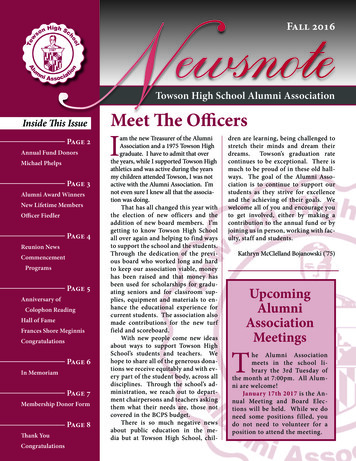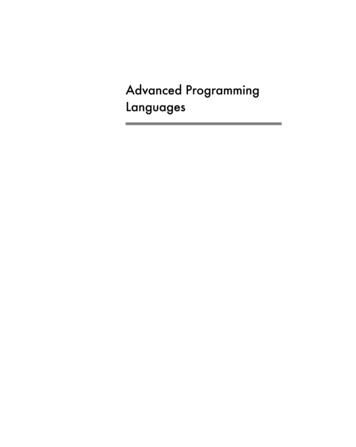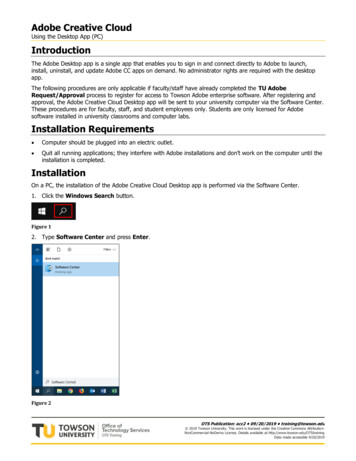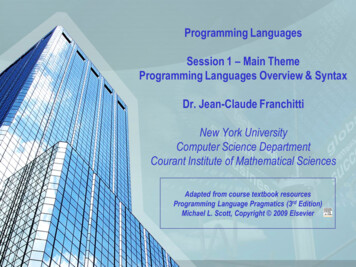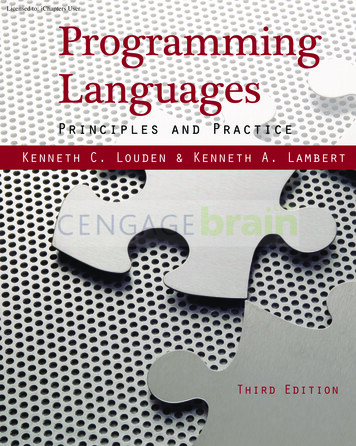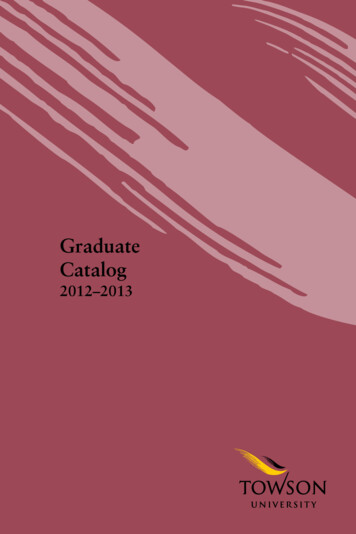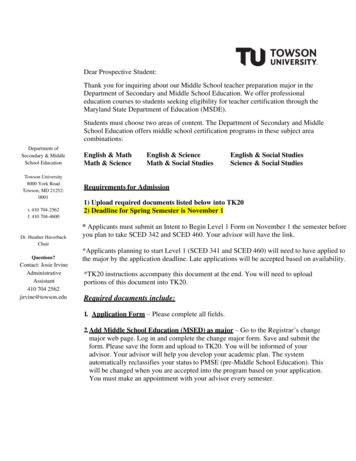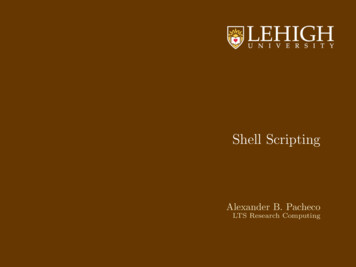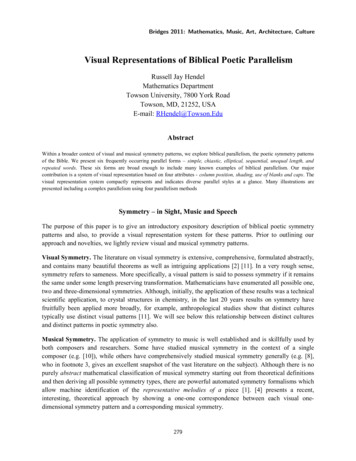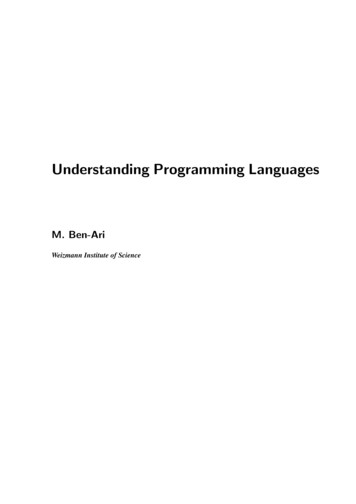
Transcription
Understanding Programming LanguagesM. Ben-AriWeizmann Institute of Science
Originally published by John Wiley & Sons, Chichester, 1996.c 2006 by M. Ben-Ari.Copyright You may download, display and print one copy for your personal use in non-commercial academicresearch and teaching. Instructors in non-commerical academic institutions may make one copyfor each student in his/her class. All other rights reserved. In particular, posting this document onweb sites is prohibited without the express permission of the author.
ContentsPrefacexiI Introduction to Programming Languages11 What Are Programming Languages?21.1The wrong question . . . . . . . . . . . . . . . . . . . . . . . . . . . . . . . . .21.2Imperative languages . . . . . . . . . . . . . . . . . . . . . . . . . . . . . . . .41.3Data-oriented languages . . . . . . . . . . . . . . . . . . . . . . . . . . . . . .71.4Object-oriented languages . . . . . . . . . . . . . . . . . . . . . . . . . . . . .111.5Non-imperative languages . . . . . . . . . . . . . . . . . . . . . . . . . . . . .121.6Standardization . . . . . . . . . . . . . . . . . . . . . . . . . . . . . . . . . . .131.7Computer architecture . . . . . . . . . . . . . . . . . . . . . . . . . . . . . . .131.8* Computability . . . . . . . . . . . . . . . . . . . . . . . . . . . . . . . . . . .161.9Exercises . . . . . . . . . . . . . . . . . . . . . . . . . . . . . . . . . . . . . .172 Elements of Programming Languages182.1Syntax . . . . . . . . . . . . . . . . . . . . . . . . . . . . . . . . . . . . . . . .182.2* Semantics . . . . . . . . . . . . . . . . . . . . . . . . . . . . . . . . . . . . .202.3Data . . . . . . . . . . . . . . . . . . . . . . . . . . . . . . . . . . . . . . . . .212.4The assignment statement . . . . . . . . . . . . . . . . . . . . . . . . . . . . . .222.5Type checking . . . . . . . . . . . . . . . . . . . . . . . . . . . . . . . . . . . .232.6Control statements . . . . . . . . . . . . . . . . . . . . . . . . . . . . . . . . .242.7Subprograms . . . . . . . . . . . . . . . . . . . . . . . . . . . . . . . . . . . .242.8Modules . . . . . . . . . . . . . . . . . . . . . . . . . . . . . . . . . . . . . . .252.9Exercises . . . . . . . . . . . . . . . . . . . . . . . . . . . . . . . . . . . . . .26v
Contentsvi3 Programming Environments273.1Editor . . . . . . . . . . . . . . . . . . . . . . . . . . . . . . . . . . . . . . . .283.2Compiler . . . . . . . . . . . . . . . . . . . . . . . . . . . . . . . . . . . . . .283.3Librarian . . . . . . . . . . . . . . . . . . . . . . . . . . . . . . . . . . . . . .303.4Linker . . . . . . . . . . . . . . . . . . . . . . . . . . . . . . . . . . . . . . . .313.5Loader . . . . . . . . . . . . . . . . . . . . . . . . . . . . . . . . . . . . . . . .323.6Debugger . . . . . . . . . . . . . . . . . . . . . . . . . . . . . . . . . . . . . .323.7Profiler . . . . . . . . . . . . . . . . . . . . . . . . . . . . . . . . . . . . . . .333.8Testing tools . . . . . . . . . . . . . . . . . . . . . . . . . . . . . . . . . . . . .333.9Configuration tools . . . . . . . . . . . . . . . . . . . . . . . . . . . . . . . . .343.10 Interpreters . . . . . . . . . . . . . . . . . . . . . . . . . . . . . . . . . . . . .343.11 The Java model . . . . . . . . . . . . . . . . . . . . . . . . . . . . . . . . . . .353.12 Exercises . . . . . . . . . . . . . . . . . . . . . . . . . . . . . . . . . . . . . .37II Essential Concepts384 Elementary Data Types394.1Integer types . . . . . . . . . . . . . . . . . . . . . . . . . . . . . . . . . . . . .394.2Enumeration types . . . . . . . . . . . . . . . . . . . . . . . . . . . . . . . . .434.3Character type . . . . . . . . . . . . . . . . . . . . . . . . . . . . . . . . . . . .464.4Boolean type . . . . . . . . . . . . . . . . . . . . . . . . . . . . . . . . . . . .474.5* Subtypes . . . . . . . . . . . . . . . . . . . . . . . . . . . . . . . . . . . . . .484.6* Derived types . . . . . . . . . . . . . . . . . . . . . . . . . . . . . . . . . . .504.7Expressions . . . . . . . . . . . . . . . . . . . . . . . . . . . . . . . . . . . . .524.8Assignment statements . . . . . . . . . . . . . . . . . . . . . . . . . . . . . . .554.9Exercises . . . . . . . . . . . . . . . . . . . . . . . . . . . . . . . . . . . . . .575 Composite Data Types595.1Records . . . . . . . . . . . . . . . . . . . . . . . . . . . . . . . . . . . . . . .595.2Arrays . . . . . . . . . . . . . . . . . . . . . . . . . . . . . . . . . . . . . . . .625.3Reference semantics in Java . . . . . . . . . . . . . . . . . . . . . . . . . . . .645.4Arrays and type checking . . . . . . . . . . . . . . . . . . . . . . . . . . . . . .665.5* Array subtypes in Ada . . . . . . . . . . . . . . . . . . . . . . . . . . . . . .695.6String type . . . . . . . . . . . . . . . . . . . . . . . . . . . . . . . . . . . . . .705.7Multi-dimensional arrays . . . . . . . . . . . . . . . . . . . . . . . . . . . . . .72
Contentsvii5.8Array implementation . . . . . . . . . . . . . . . . . . . . . . . . . . . . . . . .735.9* Representation specification . . . . . . . . . . . . . . . . . . . . . . . . . . .765.10 Exercises . . . . . . . . . . . . . . . . . . . . . . . . . . . . . . . . . . . . . .806 Control Structures826.1switch-/case-statements . . . . . . . . . . . . . . . . . . . . . . . . . . . . . . .826.2if-statements . . . . . . . . . . . . . . . . . . . . . . . . . . . . . . . . . . . . .866.3Loop statements . . . . . . . . . . . . . . . . . . . . . . . . . . . . . . . . . . .916.4for-statements . . . . . . . . . . . . . . . . . . . . . . . . . . . . . . . . . . . .946.5Sentinels . . . . . . . . . . . . . . . . . . . . . . . . . . . . . . . . . . . . . . .996.6* Invariants . . . . . . . . . . . . . . . . . . . . . . . . . . . . . . . . . . . . . 1006.7goto-statements . . . . . . . . . . . . . . . . . . . . . . . . . . . . . . . . . . . 1026.8Exercises . . . . . . . . . . . . . . . . . . . . . . . . . . . . . . . . . . . . . . 1037 Subprograms1057.1Subprograms: procedures and functions . . . . . . . . . . . . . . . . . . . . . . 1057.2Parameters . . . . . . . . . . . . . . . . . . . . . . . . . . . . . . . . . . . . . . 1077.3Passing parameters to a subprogram . . . . . . . . . . . . . . . . . . . . . . . . 1097.4Block structure . . . . . . . . . . . . . . . . . . . . . . . . . . . . . . . . . . . 1177.5Recursion . . . . . . . . . . . . . . . . . . . . . . . . . . . . . . . . . . . . . . 1227.6Stack architecture . . . . . . . . . . . . . . . . . . . . . . . . . . . . . . . . . . 1247.7More on stack architecture . . . . . . . . . . . . . . . . . . . . . . . . . . . . . 1307.8* Implementation on the 8086 . . . . . . . . . . . . . . . . . . . . . . . . . . . 1327.9Exercises . . . . . . . . . . . . . . . . . . . . . . . . . . . . . . . . . . . . . . 134III Advanced Concepts1368 Pointers1378.1Pointer types . . . . . . . . . . . . . . . . . . . . . . . . . . . . . . . . . . . . 1378.2Data structures . . . . . . . . . . . . . . . . . . . . . . . . . . . . . . . . . . . 1438.3Dynamic data structures in Java . . . . . . . . . . . . . . . . . . . . . . . . . . 1498.4Equality and assignment in Java . . . . . . . . . . . . . . . . . . . . . . . . . . 1498.5Memory allocation . . . . . . . . . . . . . . . . . . . . . . . . . . . . . . . . . 1518.6Algorithms for heap allocation . . . . . . . . . . . . . . . . . . . . . . . . . . . 1538.7Exercises . . . . . . . . . . . . . . . . . . . . . . . . . . . . . . . . . . . . . . 156
Contentsviii9 Real Numbers1579.1Representations of real numbers . . . . . . . . . . . . . . . . . . . . . . . . . . 1579.2Language support for real numbers . . . . . . . . . . . . . . . . . . . . . . . . . 1609.3The three deadly sins . . . . . . . . . . . . . . . . . . . . . . . . . . . . . . . . 1639.4* Real types in Ada . . . . . . . . . . . . . . . . . . . . . . . . . . . . . . . . . 1659.5Exercises . . . . . . . . . . . . . . . . . . . . . . . . . . . . . . . . . . . . . . 16610 Polymorphism16810.1 Type conversion . . . . . . . . . . . . . . . . . . . . . . . . . . . . . . . . . . . 16810.2 Overloading . . . . . . . . . . . . . . . . . . . . . . . . . . . . . . . . . . . . . 16910.3 Generics . . . . . . . . . . . . . . . . . . . . . . . . . . . . . . . . . . . . . . . 17110.4 Polymorphic data structures in Java . . . . . . . . . . . . . . . . . . . . . . . . 17410.5 Variant records . . . . . . . . . . . . . . . . . . . . . . . . . . . . . . . . . . . 17510.6 Dynamic dispatching . . . . . . . . . . . . . . . . . . . . . . . . . . . . . . . . 17810.7 Exercises . . . . . . . . . . . . . . . . . . . . . . . . . . . . . . . . . . . . . . 17911 Exceptions18011.1 Exception handling requirements . . . . . . . . . . . . . . . . . . . . . . . . . . 18011.2 Exceptions in PL/I . . . . . . . . . . . . . . . . . . . . . . . . . . . . . . . . . 18111.3 Exceptions in Ada . . . . . . . . . . . . . . . . . . . . . . . . . . . . . . . . . . 18211.4 Exceptions in C . . . . . . . . . . . . . . . . . . . . . . . . . . . . . . . . . 18411.5 Error handling in Eiffel . . . . . . . . . . . . . . . . . . . . . . . . . . . . . . . 18611.6 Exercises . . . . . . . . . . . . . . . . . . . . . . . . . . . . . . . . . . . . . . 18912 Concurrency19012.1 What is concurrency? . . . . . . . . . . . . . . . . . . . . . . . . . . . . . . . . 19012.2 Shared memory . . . . . . . . . . . . . . . . . . . . . . . . . . . . . . . . . . . 19112.3 The mutual exclusion problem . . . . . . . . . . . . . . . . . . . . . . . . . . . 19312.4 Monitors and protected objects . . . . . . . . . . . . . . . . . . . . . . . . . . . 19412.5 Concurrency in Java . . . . . . . . . . . . . . . . . . . . . . . . . . . . . . . . . 19512.6 Message passing . . . . . . . . . . . . . . . . . . . . . . . . . . . . . . . . . . 19712.7 occam . . . . . . . . . . . . . . . . . . . . . . . . . . . . . . . . . . . . . . . . 19812.8 Ada rendezvous . . . . . . . . . . . . . . . . . . . . . . . . . . . . . . . . . . . 19912.9 Linda . . . . . . . . . . . . . . . . . . . . . . . . . . . . . . . . . . . . . . . . 20012.10Exercises . . . . . . . . . . . . . . . . . . . . . . . . . . . . . . . . . . . . . . 202
ContentsixIV Programming Large Systems20413 Program Decomposition20513.1 Separate compilation . . . . . . . . . . . . . . . . . . . . . . . . . . . . . . . . 20613.2 Why are modules needed? . . . . . . . . . . . . . . . . . . . . . . . . . . . . . 21013.3 Packages in Ada . . . . . . . . . . . . . . . . . . . . . . . . . . . . . . . . . . . 21113.4 Abstract data types in Ada . . . . . . . . . . . . . . . . . . . . . . . . . . . . . 21513.5 How to write modules in C . . . . . . . . . . . . . . . . . . . . . . . . . . . 22013.6 Exercises . . . . . . . . . . . . . . . . . . . . . . . . . . . . . . . . . . . . . . 22314 Object-Oriented Programming22514.1 Object-oriented design . . . . . . . . . . . . . . . . . . . . . . . . . . . . . . . 22514.2 Object-oriented programming in C . . . . . . . . . . . . . . . . . . . . . . . 22714.3 Inheritance . . . . . . . . . . . . . . . . . . . . . . . . . . . . . . . . . . . . . 22914.4 Dynamic polymorphism in C . . . . . . . . . . . . . . . . . . . . . . . . . . 23114.5 Object-oriented programming in Ada 95 . . . . . . . . . . . . . . . . . . . . . . 23714.6 Exercises . . . . . . . . . . . . . . . . . . . . . . . . . . . . . . . . . . . . . . 24215 More on Object-Oriented Programming24415.1 Structuring classes . . . . . . . . . . . . . . . . . . . . . . . . . . . . . . . . . 24415.2 Encapsulation in Java . . . . . . . . . . . . . . . . . . . . . . . . . . . . . . . . 25115.3 Access to private components . . . . . . . . . . . . . . . . . . . . . . . . . . . . 25315.4 Class data . . . . . . . . . . . . . . . . . . . . . . . . . . . . . . . . . . . . . . 25815.5 The Eiffel programming language . . . . . . . . . . . . . . . . . . . . . . . . . 26115.6 Design considerations . . . . . . . . . . . . . . . . . . . . . . . . . . . . . . . . 26715.7 Methods of dynamic polymorphism . . . . . . . . . . . . . . . . . . . . . . . . 27015.8 Exercises . . . . . . . . . . . . . . . . . . . . . . . . . . . . . . . . . . . . . . 271V Non-imperative Programming Languages27316 Functional Programming27416.1 Why functional programming? . . . . . . . . . . . . . . . . . . . . . . . . . . . 27416.2 Functions . . . . . . . . . . . . . . . . . . . . . . . . . . . . . . . . . . . . . . 27516.3 Compound types . . . . . . . . . . . . . . . . . . . . . . . . . . . . . . . . . . 27616.4 Higher-order functions . . . . . . . . . . . . . . . . . . . . . . . . . . . . . . . 279
Contentsx16.5 Lazy and eager evaluation . . . . . . . . . . . . . . . . . . . . . . . . . . . . . 28116.6 Exceptions . . . . . . . . . . . . . . . . . . . . . . . . . . . . . . . . . . . . . . 28316.7 Environments . . . . . . . . . . . . . . . . . . . . . . . . . . . . . . . . . . . . 28316.8 Exercises . . . . . . . . . . . . . . . . . . . . . . . . . . . . . . . . . . . . . . 28517 Logic Programming28717.1 Pure logic programming . . . . . . . . . . . . . . . . . . . . . . . . . . . . . . 28717.2 Unification . . . . . . . . . . . . . . . . . . . . . . . . . . . . . . . . . . . . . 29017.3 Prolog . . . . . . . . . . . . . . . . . . . . . . . . . . . . . . . . . . . . . . . . 29217.4 Advanced logic programming concepts . . . . . . . . . . . . . . . . . . . . . . 29917.5 Exercises . . . . . . . . . . . . . . . . . . . . . . . . . . . . . . . . . . . . . . 300A Selected Bibliography302Index305
PrefaceThe importance of programming languagesTo say that a good programmer can write good software in any language is like saying that a goodpilot can fly any aircraft: true, but irrelevant. A passenger aircraft is designed for safety, comfortand economic viability; a military aircraft is designed for performance and mission capability; anultralite aircraft is designed for low cost and operational simplicity.The role of language in programming has been downgraded in favor of software methodologyand tools; not just downgraded, but totally repudiated when it is claimed that a well-designedsystem can be implemented equally well in any language. But programming languages are notjust a tool; they furnish the raw material of software, the thing we look at on our screens mostof the day. I believe that the programming language is one of the most important, not one of theleast important, factors that influence the ultimate quality of a software system. Unfortunately, toomany programmers have poor linguistic skills. He/she is passionately in love with his/her “native”programming language, but is not able to analyze and compare language constructs, nor to understand the advantages and disadvantages of modern languages and language concepts. Too often,one hears statements that demonstrate conceptual confusion: “Language L1 is more powerful (ormore efficient) than language L2”.This lack of knowledge is a contributing factor to two serious problems in software. The first isthe ultra-conservatism that exists in the choice of programming languages. Despite the explosiveadvances in computer hardware and the sophistication of modern software systems, most programming is still done in languages that were developed about 1970, if not earlier. Extensive researchin programming languages is never tested in practice, and software developers are forced to usetools and methodologies to compensate for obsolete language technology. It is as if airlines wouldrefuse to try jet aircraft on the grounds that an old-fashioned propeller aircraft is perfectly capableof getting you from here to there.The second problem is that language constructs are used indiscriminately, with little or no regardfor safety or efficiency. This leads to unreliable software that cannot be maintained, as well asto inefficiencies that are solved by assembly language coding, rather than by refinement of thealgorithms and the programming paradigms.Programming languages exist only for the purpose of bridging the gap in the level of abstractionbetween the hardware and the real world. There is an inevitable tension between higher levels ofabstraction that are easier to understand and safer to use, and lower levels of abstraction that arexi
Prefacexiimore flexible and can often be implemented more efficiently. To design or choose a programminglanguage is to select an appropriate level of abstraction, and it is not surprising that differentprogrammers prefer different levels, or that one language may be appropriate for one project andnot for another. Within a specific language, a programmer should understand in depth the safetyand efficiency implications of each construct in the language.The aim of the bookThe aim of this book is to help the student understand programming languages by analyzing andcontrasting language constructs: What alternatives are available to the language designer? How are language constructs implemented? How should they be used?We have not hesitated to be prescriptive: to claim that accumulated experience shows that certainconstructs are to be preferred, and others to be avoided or at least used with caution.Of course, any book on programming languages should not be taken as a reference manual for anyparticular language. The goal is to learn to analyze languages and not to study the peculiaritiesof any language in depth. Nor is the book a guide to the choice of a language for any particularproject. The goal is to supply the student with the conceptual tools needed to make such a decision.Selection of the materialThe author of a text on programming languages must necessarily offend at least 3975 of the 4000or so inventors of programming languages! I made the conscious decision to focus on a very smallnumber of languages (even if it means offending 3994 people), because I believe that I can explainmost language concepts using these languages. Other languages are mentioned or surveyed onlyif they demonstrate some concept that is not found in the languages chosen for the mainstream ofthe presentation.Much of the book is concerned with “ordinary” imperative languages and two languages havebeen chosen from this class. Representing languages with a low level of abstraction is C, whichhas overtaken Fortran as the dominant language in this category. To represent a higher level ofabstraction we have chosen Ada which offers a much cleaner definition than the more widelyknown Pascal.An additional justification for these choices is that both languages have extensions (C andAda 95) that we can use to study language support for object-oriented programming, currentlythe dominant programming method.Unfortunately (I believe) most programming today is still done in imperative languages, but inrecent years the quality of implementations for non-imperative languages has improved so that
Prefacexiiithey can be used to develop “real” software. The final chapters introduce functional (ML) and logicprogramming (Prolog) languages in the hope of convincing the student that imperative languagesare not conceptual necessities for programming.The theory of programming language syntax and semantics is beyond the scope of this text. Theseimportant subjects are best left to more advanced courses.To prevent confusion when comparing examples from different languages, an indication likeC is attached to each example. In a section that discusses constructs in a specific language,no indication will be given.Overview of the materialPart I is descriptive, defining and surveying programming languages and environments. Part IIexplains in great detail the basic constructs of programming languages: types, statements andsubprograms. Part III continues the discussion of more advanced programming constructs suchas: real numbers, static polymorphism, error handling and concurrency. Part IV is devoted toprogramming large systems with emphasis on language support for object-oriented programming.Finally, Part V surveys the basic concepts of functional and logic programming.Teaching recommendationsThe prerequisite for this book is at least one year of programming in some language such as Pascalor C. In any case, the student should have a basic reading knowledge of C. A familiarity with thestructure and machine code of some computer will also be helpful.There is too much material for a single course. Parts I and II together with portions of Part IVon modules and object-oriented programming can form the basis of a one-semester course forsecond-year undergraduates. For advanced undergraduates, the first half can be quickly reviewedin order to concentrate on the more difficult material in Parts III and IV. An advanced courseshould certainly include Part V supplemented by more material on some non-imperative languagechosen by the instructor. Starred sections are more appropriate for advanced students.Students should also be taught how to examine the assembly language instructions that are emittedby the compilers that they use.Exercises: since this is a book on programming languages and not on programming, the emphasisin the exercises is not on programming projects. Instead, we ask the students to dig into languagedescriptions, compare languages and verify compiler implementations of language constructs. Theinstructor is encouraged to tailor the exercises and append others, according to personal taste andthe availability of tools.The book will also be useful to programmers who wish to deepen their knowledge of the toolsthey use daily: programming languages.
PrefacexivA personal noteI admit that I prefer higher to lower levels of abstraction. This is not a prejudice, but a “postjudice”. We software engineers have an exceedingly dismal record when it comes to producingreliable software systems, and I believe that part of the solution lies in higher levels of abstractionin programming languages. To expand on Dijkstra’s saying: if you have a 100,000-line programthat you can’t understand, you should rewrite it as a 10,000-line program in a higher-level programming language.My formative experience was in the early 1970’s as a member of a large team of programmersworking on a financial transaction system. We actually installed a new on-line system, even thoughwe knew the system had a bug that we could not locate. Several weeks later the bug was finallytrapped: it turned out that poor design of the programming language being used had turned a trivialtypographical mistake into a type mismatch. A couple of years later when I first saw Pascal, I washooked. The addiction deepened each time I helped a scientist who had wasted weeks of his/herlife searching for a bug that would not have compiled successfully in Pascal. While type mismatchis certainly not the only source of programming error, it is so common and so dangerous, yet sosimple to catch, that I would no more abandon strong type checking than I would drive without aseat-belt: it may be uncomfortable but even the best drivers can be involved in an accident and thediscomfort is trivial relative to the potential damage.I do not wish to get involved in language “wars” claiming that one language is better than anotherfor any specific machine or application. I have attempted to analyze language constructs as objectively as I can in the hope that this will contribute to making discussions about language morescientific.AcknowledgementsI would like to thank Kevlin A.P. Henney and David W. Barron for comprehensive reviews of themanuscript, as well as Harry Mairson, Tamar Benaya and Bruria Haberman who read portionsof the manuscript. I am indebted to Amiram Yehudai for serving as my object-oriented guru:guiding me during numerous discussions and carefully checking the relevant chapters. EdmondSchonberg, Robert Dewar and their team at NYU quickly responded to my questions on GNAT,making it possible for me to learn and to write about Ada 95 even before a full compiler wasavailable. Ian Joyner kindly provided his unpublished analysis of C which was most helpful.Like my previous books, this book would probably not have been written without Leslie Lamport’sLATEX!It has been my privilege to work with a very professional and efficient publishing team at JohnWiley, and I would like to thank them, especially my editor Gaynor Redvers-Mutton, for thisopportunity.M. Ben-AriRehovot, IsraelOctober 1995
PrefacexvPreface to the online editionThis edition contains the same text as the printed book, except that: errors have been corrected,1the extra material on Java has been integrated into the text, and the appendix on obtaining compilers has been removed. The document has been reset in a different font and with dimensionssuitable for office printers.I have since written an Ada textbook (Ada for Software Engineers) which is also available for freeon my website.An instructor’s manual is available by writing me.M. Ben-AriRehovot, 20061 Thanksto the Russian translator Vsevolod Shtarkman for finding many errors in the text.
Part IIntroduction toProgrammingLanguages1
1What Are Programming Languages?1.1 The wrong questionWhen one first encounters a new programming language, the first question is usually:What can this language “do”?Implicitly we are comparing the new language with other languages. The answer is very simple:all languages can “do” exactly the same computations! Section 1.8 outlines the justification forthis answer. If they can all do the same computations, surely there must be other reasons for theexistence of hundreds of programming languages.Let us start with some definitions:A program is a sequence of symbols that specifies a computation. A programminglanguage is a set of rules that specify which sequences of symbols constitute a program, and what computation the program describes.You may find it interesting that the definition does not mention the word computer! Programsand languages can be defined as purely formal mathematical objects. However, more people areinterested in programs than in other mathematical objects such as groups, precisely because it ispossible to use the program—the sequence of symbols—to control the execution of a computer.While we highly recommend the study of the theory of programming, this text will generally limititself to the study of programs as they are executed on a computer.These definitions are very general and should be interpreted as generally as possible. For example,sophisticated word processors usually have a facility that enables you to “capture” a sequence ofkey-presses and store them as a macro so that you can execute the entire sequence by pressing asingle key. This is certainly a program because the sequence of key-presses specifies a computationand the software manual will clearly specify the macro language: how to initiate, terminate andname a macro definition.To answer the question in the title of the chapter, we first go back to early digital computers, whichwere very much like the simple calculators used today by your grocer in that the computation thatsuch computers perform is “wired-in” and cannot be changed.The most significant early advance in computers was the realization (attributed to John von Neumann) that the specification of the computation, the program, can be stored in the computer just as2
1.1. THE WRONG QUESTION3easily as the data used in the computation. The stored-program computer thus becomes a generalpurpose calculating machine and we can change the program just by changing a plugboard ofwires, feeding a punched card, inserting a diskette, or connecting to a telephone line.Since computers are binary machines that recognize only zeros and ones, storing programs in acomputer is technically easy but practically inconvenient, since each instruction has to be writtenas binary digits (bits) that can be represented mechanically or electronically. One of the firstsoftware tools was the symbolic assembler. An assembler takes a program written in assemblylanguage, which represents each instruction as a symbol, and translates the symbols into a binaryrepresentation suitable for execution on the computer. For example, the instruction:loadR3,54meaning “load register 3 with the data in memory location 54”, is much more readable than theequivalent string of bits. Believe it or not, the term automatic programming originally referredto assemblers since they automatically selected the right bit sequence for each symbol. Familiarprogramming languages like C and Pascal are more sophisticated than assemblers because they“automatically” choose addresses and registers, and even “automatically” choose instruction sequences to specify loops and arithmetical expressions.We are now ready to answer the question in the title of this chapter:A programming language is an abstraction mechanism. It enables a programmer tospecify a computation abstractly, and to let a program (usually called an assembler,compiler or interpreter) implement the specification in the detailed form needed forexecution on a computer.We can also understand why there are hundreds of programming languages: two different classesof problems may demand different levels of abstraction, and different programmers have differentideas on how abstraction should be done. A C programmer is perfectly content to work at a levelof abstraction that requires specification of computations using arrays and indices, while an authorof a report prefers to “program” using a language consisting of the functions of a word-processor.Levels of abstraction can be clearly seen in computer hardware. Originally, discrete componentslike transistors and resistors were wired directly to one another. Then standard plug-in moduleswere used, followed by small-scale integrated circuits. Today, entire computers can be constructedfrom a handful of chips each containing hundreds of thousands of components. No computerengineer would dare to design an “optimal” circuit from individual components if there exists aset of chips that can be adapted do to the s
algorithms and the programming paradigms. Programming languages exist only for the purpose of bridging the gap in the level of abstraction between the hardware and the real world. There is an inevitable tension between higher levels of abstraction that are easier to understand and safer to use, and lower levels of abstraction that are xi

